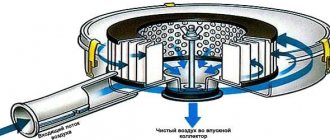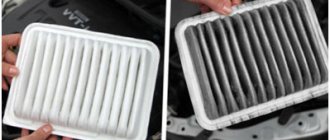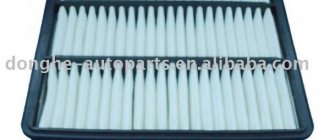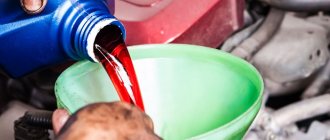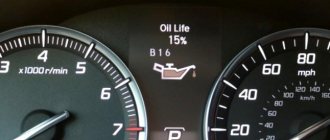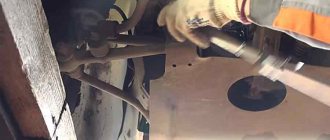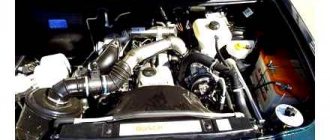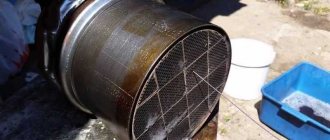Proper operation of a car engine is possible under certain conditions. Fuel continuously enters the combustion chamber and must be mixed with air. The latter comes from the environment. But, taking into account the operating conditions of the car, the air mass must be pre-cleaned. A separate element is responsible for this - the air filter in the car. It is connected to two lines: the intake line, through which the main flow passes, and the exhaust line, where the already filtered oxygen enters the injection or carburetor system.
The service life of the motor itself depends on the proper operation of the filter. Moreover, the state of the element dictates the performance parameters of the power unit. This article discusses the sequence of actions during replacement, indicates signs of severe wear and common mistakes that car owners make.
Why do you need to change the air filter in your car?
If the car is deprived of a filter, unpurified air will begin to enter the combustion chamber. It consists of a huge amount of harmful substances - soot, dust, dirt, sometimes even particulate matter. And this is not to mention the insects that the car “collects” when driving at high speed (for example, on the highway).
The design of the filter element consists of a package of filter meshes. They do not allow contaminants and solid particles to penetrate further and mix with the fuel in the carburetor. When the vehicle is constantly used on dusty roads (for example, on gravel roads, country roads or field junctions), the honeycombs become heavily clogged with dust. What does this mean?
At first, the engine will not receive air in a volume sufficient for high-quality ignition of the working mixture inside the combustion chamber. The result is obvious - fuel consumption increases significantly. The whole difficulty is that the driver will not immediately notice changes in the behavior of the engine, especially if we are talking about a modern foreign car controlled by an electronic unit. The latter simply adapts to the current parameters of the airway throughput. To maintain rated power, the unit will begin to fill with fuel more intensively. This situation greatly reduces the engine's resources, because the fuel does not burn out completely and debris begins to accumulate in the cylinders. The results can be sad:
- catalyst coking;
- clogging of the flame arrester (if any);
- the appearance of scoring on the walls of the combustion chamber block;
- increased load on the working elements of the engine.
Therefore, the issue of the current state of the filter must be taken seriously. Naturally, if you don’t want to then spend a lot of money on a major overhaul of the motor or its complete replacement.
Purpose of the air filter
To understand how often the engine air filter is changed, you must first find out the purpose of this part. This element is present in any car model. It prevents dust and road dirt from entering the engine combustion chamber. If there were no filter, foreign particles would enter the motor and interfere with its operation.
During fuel combustion, oxygen is consumed (after all, without it this process is impossible). Per 100 km, the engine consumes 12-15 m³ of air. Therefore, monitoring the condition of the filter is extremely important. Over time, dust gets inside it. The motor cannot operate at full power. More fuel is consumed than with a new filter.
In addition to the listed functions, the air filter also functions as a muffler. In gasoline engines, it also regulates the heating temperature of the fuel.
How often should you change the air filter?
How often should you change the air filter? The answer will seem obvious - in accordance with the manufacturer’s regulations. In fact, this is not always the case. The technical documentation contains general values that you need to focus on. That is, there is practically no accurate information here.
The owner must understand that the quality of the filter depends on several factors:
- the current condition of the engine (if it leaks oil, a new cleaning element will not be enough for 1,500 kilometers);
- the total service life specified by the manufacturer of the consumable;
- the type of surface on which the car primarily drives. In the case of asphalt pavement, which is regularly maintained by utility services, the frequency is reduced to the values prescribed in the technical documentation. But when driving on field, country or gravel roads, this value must be reduced by 30-50 percent;
- operating style. A car that is regularly accelerated to 130-160 km per hour is capable of consuming air in a ratio of 1:15 (one part gasoline to 15 parts air). It’s easy to guess that a full tank with a volume of 60 liters accounts for about 900 kilograms of air. And the faster the car moves, the more the air volume increases.
Note! The standard values prescribed by the manufacturer are not the ultimate truth. The basic criterion is the operating style of the car and the conditions in which it drives.
Air filter capabilities
The effectiveness of so-called “wet” filters that purify liquids - fuel, oil, coolant, etc., is usually measured in microns, which corresponds to the minimum size of particles retained. The same parameter for air filters is measured as a percentage, which determines what weight fraction of airborne contaminants this filter can retain.
Some manufacturers claim that their filters have a cleaning efficiency of 99%, while others, such as Cummins Filtration, guarantee that their air filters have an average cleaning efficiency of 99.96%. In this case, the word “average” means that during operation the degree of filter cleaning changes. When a new, clean filter is installed, its entire surface works, but over time, some of the holes become clogged, and the efficiency increases and at a certain stage reaches its maximum. In theory, a 100% filter would be ideal, but it would likely not allow any air through at all, or would have too much resistance.
It is easy to estimate what the percentage indicator means for a particular consumer by calculating how much dirt gets into the engine when it operates with a particular filter. So, 99% efficiency means that if 1000 g of dust gets onto the filter, then 10 g of this amount will enter the engine. And with an efficiency of 99.96%, only 0.4 g of dust will enter the engine. So if someone offers a “good” filter with 99% efficiency, you should question whether it is really good.
How to understand that a replacement is needed
Some drivers prefer to install new filters taking into account a certain pattern. On the other hand, if you replace it every 10 thousand kilometers in a timely manner, the engine elements will “live” much longer. The first alarm bells indicating the need to install a new air purifier are the following.
- Increased fuel consumption without obvious technical reasons (on average by 15-20 percent).
- Significant reduction in power unit performance.
- Increased concentration of carbon dioxide in the exhaust system.
How to change the filter
When considering the question of how often you can change the engine air filter, something should be said about the procedure for this process itself. If necessary, contact technical service. To save money, it is quite possible to do all the steps yourself. There are no difficulties in this.
You need to open the hood. The filter is usually made of dark plastic. It is located at the top or side of the motor. The body of the purifier is held in place by several metal clips. Use a screwdriver to open them. The filter is easy to remove from the housing. In some cases it is secured with screws. In this case, they are simply unscrewed.
The filter material is usually bright so that drivers can independently assess the degree of contamination. By holding the cleaner up to the light, you can easily determine the need for replacement.
How to properly replace the air filter
Before you change the filter, you need to remember that each manufacturer positions it differently. Accordingly, the sequence of actions when installing a new element differs depending on the location of the units inside the engine compartment. But there are a number of common actions that all owners, without exception, perform.
- Open the hood.
- We find the box inside which the air filter is located. If it is hidden, you can roughly understand its location by looking at the large plastic (less often rubber) pipe.
- Remove the box cover. On modern cars it is secured with two or three latches.
- We take out the old filter and check its condition.
On the old copy, the cleaning elements contain dust, solid particles of dirt, and sometimes dried insects in their structure.
It is quite simple to understand that the old copy can no longer be used - just one glance at the honeycomb is enough. After removing the old filter, do not rush to install a new one immediately. You also need to clean the walls of the box and the pipes leading to it from accumulated dust and dirt. This can be done with a dry cloth. Next, we go over the surface with a slightly damp cloth, then dry again. Only after this should you install a new copy and perform the assembly in the reverse order indicated above.
Types of air filters
Automotive air filters installed on engines differ in their design features and, in addition, in the methods of air purification. As for the first criterion, three types can be distinguished:
According to the cleaning methods, the division occurs as follows:
So, with this information, novice motorists will be able to choose the right filter in the store. If, nevertheless, difficulties arise, you can always look at the car’s operating manual and, of course, it is advisable to look under the hood.
Basic mistakes when replacing
It would seem that installing a new filter is one of the simplest car maintenance procedures. Unfortunately, many even here manage to make a number of mistakes. Let's take a look at the most popular ones below.
The first common mistake is not to try to restore the old filter. The owners begin to wash the filter honeycombs, trying to clean them as much as possible from accumulated dirt. This is strictly prohibited. The reason lies in the behavior of the production materials. For effective cleaning, honeycombs are made of paper. It's easy to guess what will happen to it when water hits the surface. By installing such a filter back, the engine will begin to perform significantly worse. A so-called “lean” occurs when too much air enters the combustion chamber. And it definitely won’t be clean.
The second mistake is ignoring traces of oil. There should be no liquid inside the work area; motor - even more so. The presence of oily traces indicates a problem with the engine lubrication system. If you install a new filter in its original place, it will not last long. After a breakdown, the car must be sent to a service station for repairs. Technicians must check the condition of the engine and what exactly needs to be changed in it in order to avoid further oil entering the filter area.
The third common mistake is using non-original, and what’s worse, uncertified products. The first option is allowed if the filter is produced by a company that does not work directly with the manufacturer. That is, whose products are not used as standard at the factory. If there is a certificate, it means that the car brand has approved the model for use, but the owner assumes all risks regarding its performance. You should not pay the slightest attention to products without a certificate. The reason is obvious - they will not be able to work as well as licensed products. The use of non-original, uncertified filters will result in rapid engine failure. Moreover, this can happen at any mileage, be it 500 or 25,000 kilometers.
Causes of fuel filter malfunctions
Before gasoline enters the system, it goes through two stages of purification. In diesel engines, at the first stage, large fractions are filtered - dust and soot that got in during refueling. Then the gasoline undergoes fine purification.
This operation is performed by a fuel filter that separates the tank from the car’s engine. It removes small particles when gasoline is supplied to the power unit. This filtration stage plays an important role, since small impurities clog the injectors and negatively affect the operation of the engine.
Operating principle of the fuel filter
In diesel cars, breakdowns are often associated with the accumulation of water in the filter element housing. Temperature fluctuations cause condensation to form in the tank. To prevent accumulated moisture from mixing with diesel fuel, the filter must be equipped with a separator that removes water.
Diesel fuel is waxed and at temperatures below zero loses its fluidity properties, so the filter element is often equipped with heating elements to heat the fuel. If there is a regular model without a heater, it will be impossible to start the car in winter.
The part wears out much faster if untrustworthy fuel with foreign impurities is used. At small, little-known gas stations, it may be diluted in order to maximize profits. Various additives and additives can destroy not only the filter, but also other elements of the system.
During operation of the machine, dirt may enter the tank. Even if a car owner constantly monitors the condition of the car, he cannot avoid the ingress of dust, insects and other particles. Also, heavy dust associated with climatic conditions leads to clogging.
Sometimes problems begin immediately after installing a new filter. The engine stalls when starting, although it worked fine with the old part. Most likely, the new spare part did not fit a few centimeters in height.
The filter is under high pressure, the parameters of which are calculated by the automaker that manufactured the car. The pressure level will change if the dimensions of the product do not correspond to the specified parameters. This will affect the engine's performance and it will stop starting.
The main breakdowns and their causes are presented below:
| Symptoms of a clogged fuel filter | ||
| Motor type | Symptoms | Filter life |
| Carburetor | Almost invisible due to the high degree of fuel purification. | 10,000 - 15,000 km |
| Injector | Reduced engine power. | 30,000 - 50,000 km |
| Diesel | The engine does not start the first time. | 24,000 - 40,000 km |
| There is noticeable jerking when moving. | ||
Expert recommendations
Experienced car enthusiasts are ready to give advice on how often to change the engine air filter. They recommend combining this procedure with changing the engine oil. As a rule, this happens once every 10-15 km. In this case, it will be possible to service the entire engine, ensuring its long-term reliable operation.
In order for the procedure to go quickly, you need to read the manufacturer’s instructions in advance and understand the structure of the engine. You must purchase an air filter in accordance with the make of your car. More modern devices may also be available for sale. But before purchasing them, it is necessary to determine whether such filters are suitable for the system of a particular motor model.
Experts also advise not to save on purchasing such spare parts. After all, the performance of the entire motor depends on the quality of the filter. Repairing or even replacing it will be very expensive.
